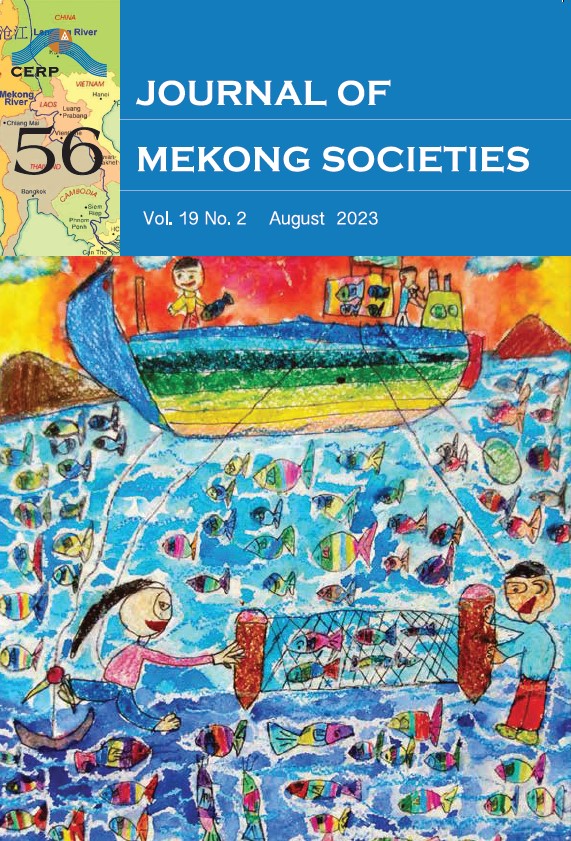Promoting Camaraderie or Destroying a Relationship: Addressing a Person with an Animal Name in Thai Culture
Main Article Content
Abstract
Addressing a person with an animal name is a social practice in Thai culture. Interpreting the meaning of the animal name as an address term depends on complex processes in which each individual, either in the same culture or a different culture, might perceive and interpret the meanings of the terms differently. Despite these possible different interpretations, it is interesting to investigate why many Thais still use an animal nickname to address someone rather than using that person’s name. This study examines the functions of addressing a person with an animal name and factors affecting different construals of the meanings of animal names between the speaker and the addressed person based on cognitive semantic and pragmatic approaches. Questionnaires and interviews were used to collect data from 800 Thai informants. The results reveal the following five functions of addressing a person with an animal name: 1) conveying a vivid picture of the addressed person’s characteristics, 2) lessening offensive meanings of taboo words, 3) teasing the addressed person, 4) creating a close relationship with the addressed person, and 5) bullying the addressed person. It can be concluded that this practice can either promote camaraderie when the name is used to create a close relationship, or destroy a relationship when used as a means of verbal bullying. Consequently, when addressing someone with an animal name in Thai culture, three factors must be considered: the intimacy of the speakers, the gender of the speakers, group membership, and the formality of the situation.
Article Details

This work is licensed under a Creative Commons Attribution-NonCommercial-NoDerivatives 4.0 International License.
References
Brown, P. and Levinson, S. (1987). Politeness: Some universals in language uses. Cambridge: Cambridge University Press.
Divjak, D., Milin, P., and Medimorec, S. (2020). Construal in language: A visual-world approach to the effects of linguistic alternations on event perception and conception. Cognitive Linguistics, 31(1), 37-72. https://doi.org/10.1515/cog-2018-0103
Evans, V. (2007). A glossary of cognitive linguistics. Edinburgh University Press.
Fatimatuzzahroh, S. S. and Setiawan, S. (2018). Swear words among males: The social functions and pragmatic meanings. Advances in Social Science, Education and Humanities Research, 222, 330-335. DOI 10.2991/soshec-18.2018.71
Gu, Y. (1990). Politeness phenomena in modern Chinese. Journal of Pragmatics, 14(2), 237- 257.
Halupka-Res, S. and Radic, B. (2003). Animal names used in addressing people in Serbian. Journal of Pragmatics, 35(March), 1891-1920.
Ide, S. (1982). Japanese sociolinguistics: Politeness and women’s language. Lingua, 57, 357-385.
Ide, S. (1989). Formal forms and discernment: Two neglected aspects of universals of linguistic politeness. Multilingua, 8, 223-248.
Langacker, R. W. (2013). Essentials of cognitive grammar. New York: Oxford University Press.
Langacker, R. W. (2017). Lecture 1–Ten lectures on the elaboration of cognitive grammar. DOI:10.1163/9789004347465
Miller, G. (1993). Images and models, similes and metaphors. In A. Ortony (Ed.). Metaphor and thought (2nd ed.). (pp. 357-400). Cambridge: Cambridge University Press.
Office of the Royal Society. (2017). Dictionary of Thai linguistic terms (General Linguistics). Bangkok: Office of the Royal Society.
Ozcan, F. H. (2016). Choice of address terms in conversational setting. International Journal of Human Sciences, 13(1), 982-1002. DOI 10.14687/ijhs.v13i1.3489
Palakornkul, A. (1972). A Socio-linguistic study of pronominal strategy in spoken Bangkok Thai. Ph.D. dissertation, Department of Linguistics. University of Texas, Austin.
Panpothong, N. (2010). 2201 783 Pragmatic analysis of Thai. Department of Thai Language, Faculty of Arts, Chulalongkorn University.
Parkinson, J. (2020). On the use of the address terms guys and mate in an educational context. Journal of Pragmatics, 161, 81-94.
Prasithrathsint, A. (2002). Language in Thai society: Diversity, change and development. 3rd ed. Bangkok: Chulalongkorn University Press.
Prasithrathsint, A. (2009). A reference book of Thai language. Norms of Thai language (Book 4): Culture of Thai usage. Bangkok: Thai Language Institute, Bureau of Academic Affairs and Educational Standards. Ministry of Education.
Rahmi, B. A. (2019). Swear words and solidarity in Ampenan communities. Advances in Social Science, Education and Humanities Research, 338, 71-75. DOI 10.2991/prasasti-19.2019.10
Surono. S. (2018). Address terms across cultures: A sociopragmatic analysis. Advances in Social Science, Education and Humanities Research, 166, 316-324. DOI 10.2991/prasasti-18.2018.59
Tingsabadh, K. and Prasithrathsint, A. (1988). The use of address terms in Thai during the Bangkok period. Research Monograph (in Thai). Bangkok: Chulalongkorn University Research Division.
Wachirapansakul, N. (2002). Chit Phumisak’s translation of address terms and pronouns in the translated version of He Who Rides a Tiger. (Master’s thesis). Bangkok, Thailand: Language and Culture for Communication and Development, Mahidol University.
Website
Puapattanakun, C. (2018). 12 Meanings of Hia. The Cloud. Retrieved June 8, 2022 from https://readthecloud.co/scoop-12meaningsofhia/


